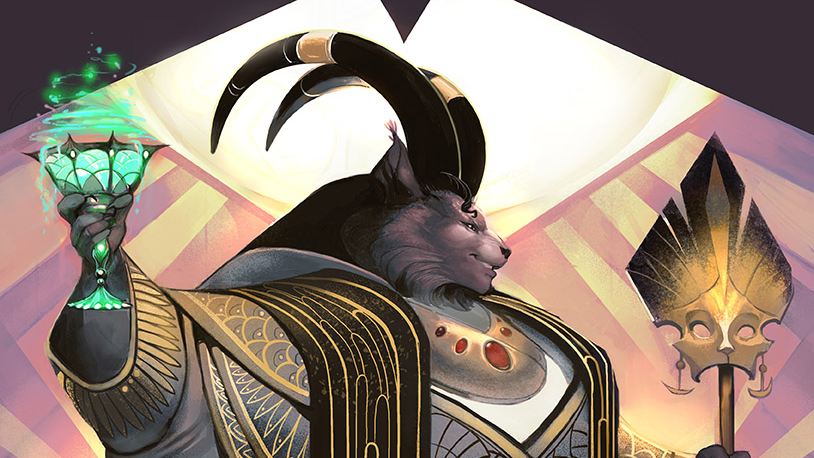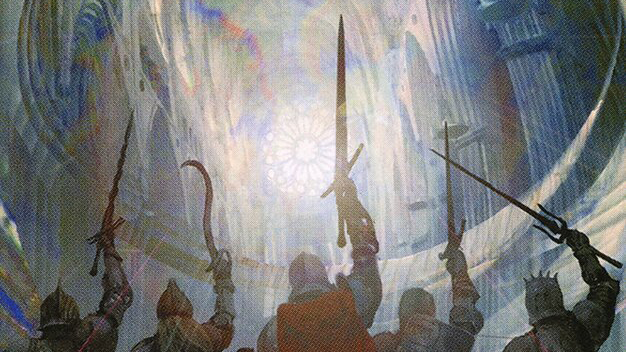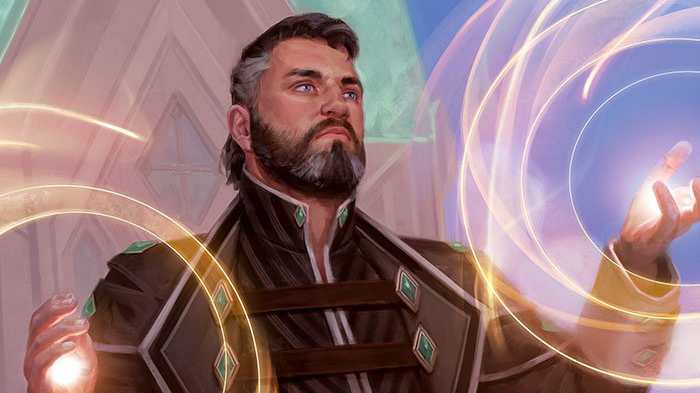Fighting With or Through Stax Pieces in cEDH

I like to mix things up in cEDH from game to game and session to session, so I’ve had plenty of reps now both with and against stax decks of various types. Slicer and Jetmir are currently in my box, but I’ve rocked with Rocco stax, I’ve dabbled in Winota, and I’ve battled against more varieties than I can fully recall.
While combo tries to ignite the kitchen, stax patiently seeks to boil the frog. Some pieces like Trinisphere, Rule of Law, Collector Ouphe, Archon of Emeria, etc. are super annoying for your combo opponents all by themselves. Other pieces like Thalia, Thorn, Weathered Runestone, Chalice of the Void, Oppo/Aven, etc. are just speedbumps in isolation but combine with each other to form a harder lock and can combine with the stronger pieces to sometimes squeeze out the entire table. Other stax pieces are blocking more specific lines of play that some, but not all, combo decks are annoyed by. Examples include Containment Priest, Cursed Totem, and Hushbringer.
When facing stax pieces there are some patterns to be aware of and some strategic considerations, especially since this is multiplayer Magic.
Accumulate Resources if You Can, Then Look for Your Window
The biggest difference I see between beginner and advanced play in the face of stax pieces is the level of patience. An experienced Tymna + Kraum player might be fine living under a stax piece or two while sculpting their hand and making land drops. A skilled RogSi pilot knows that the deck plays bounce and Dress Down (and sometimes a sweeper like Toxic Deluge) for a reason, and can assess different types of hands.
Specifically, combo decks may be looking down at 1) the type of hand that isn’t equipped to accumulate resources while it waits, in which case the situation is a bit more desperate, or 2) hands that can still make land (or mana rock) drops, maybe still tutor to set up future turns, maybe dig for cards like Dockside or bounce or Dress Down while accumulating other resources.
Hand type 1 will need to make a further assessment since even desperation takes multiple forms in cEDH. One type of desperate play is opening a window using bounce or countermagic even though the resources to exploit that window haven’t been located yet. You may need to rely on a topdeck after using bounce or countermagic. You might open a window that lets you Final Fortune without a win. These desperation plays can be correct – protecting the equity you have even if that equity doesn’t correspond to a massive, double-digit win percentage. Turning a 5% into a 10% is the stuff of expert play.
Other times, you might need to settle in for the “parasitic” desperation mode. This mode shows up when you can’t open a decent window yet and take advantage of it, but you also can’t accumulate more resources. You don’t want to concede these games, you want to wait for the other players to “duke it out” for whatever that means in the context of this game and hope that the stax player ends up thwarted and the other 1 or 2 combo players don’t find or complete the win. Is it a high percentage? Again, it often isn’t, but we’ve got to climb the win percentage hill in front of us, not dream of scaling Mt. Everest, in these spots.

Timing Can Be Everything; Try to Open Windows You Get to Climb Through First
When multiple combo decks are trying to fight through 1 or more stax pieces/opponents, there is a ton of value in doing your interaction on the turn before your own turn, not before someone else’s turn. This can be so important that you might even decide to stop another player from removing a stax piece to better control the timing of when it gets removed. Or, you might decide to let the combo opponent have their timing because you think they might get stopped during their window, which would then give you a crack at it. These assessments aren’t easy, let’s walk through an example.
Example 1:
Matt is playing Jetmir in seat 3, Alex is playing RogSi in seat 4, Drake is on Krarkashima in Seat 1, and Alana is playing Emry in Seat 2. Matt has a Rule of Law and a Thalia out, Alex doesn’t have much going on since he mulled to 3, Drake has both Krark and Sakashima out (fairly large hand size), and Alana has some mana rocks and a Rhystic Study in play (full hand). During Alex’s end step, Drake goes to bounce the Rule of Law. He is going to end up with somewhere between 0 and 3 copies of the bounce spell depending on how the flips go, but the important thought exercise here is, “How hard should Alana fight over Drake bouncing the Rule of Law? Should she use her Flusterstorm to try and keep Rule of Law in play?”
On the one hand, Alana’s deck isn’t set up to win through a Rule of Law (and a Thalia), so she’d like it to bounce at some point. And her turn follows Drake so if she can stop Drake, she’ll have an open window. On the other hand, Drake has Krarkashima assembled and has a fairly large hand of cards. This is extremely dangerous, even with some interaction in your hand and a Rhystic Study in play.
Ultimately, this is a situation where Alana is going to need to look at her hand and decide whether working to keep the table locked out, including herself, is worth it to stop Drake from winning, or whether her best chance is to hope to maybe win a few coin flips and interact a time or two and stop Drake on his turn, and get to untap without Rule of Law in play.
If I’m in Alana’s shoes and I know I’m going to have a very big, probably game-winning turn if I get to untap without Rule of Law in play and my prospects for bouncing the Rule of Law myself with better timing aren’t that great (e.g. I haven’t found a bounce spell yet), then I’m going to more often let Drake bounce the Rule of Law and just take my chances on Drake’s turn, even though he’s going to win a big percentage of the time. My explosive turn and interaction combine to let me clean up Drake’s excess equity those times he misses that critical coin flip or two, has an unusually poor hand, gets stopped by Alex or Matt randomly, or can get past my interaction.
If I’m in Alana’s shoes and it looks like I need to generally prolong the game as a first priority, because (based on what my hand happens to be), it’s unlikely I can just win it (even if Drake fizzles), then I’m more likely to use my Flusterstorm to keep Rule of Law in play, send the bounce spell to the graveyard (this is somewhat contingent upon the flips going my way but I don’t see a way around that part of the gamestate), and prolong the game while I accumulate resources and try to find ways out of the Krark situation and/or the Stax situation.
Example 2:
I’m playing Najeela and I’m in seat 4. I kept a hand of Force of Will, Pact of Negation, Mana Crypt, Taiga, Flooded Strand, Deathrite Shaman, and Eldritch Evolution. The player in seat 1 (TnK, mulled to 6) casts Mox Diamond, discards a land, plays a land, and puts Drannith Magistrate onto the stack. Player 2, on Korvold (kept 2nd 7), passes, Player 3, on Bruse + Thrassios (kept first 7), passes, and I have to decide whether to counter the Drannith or let it resolve.
Here is how my thought process will go in this situation:
Consider the impact of Drannith on me and my game plan. My hand is definitely of the “deploy my commander quickly” variety via Mana Crypt, but that’s not the only line available. I also have a mana dork to deploy and there are lots of cards I could draw that would be castable on turn 1 or turn 2. Still, I’m in the 4th seat and was hoping to get my Najeela out turn 1 rather than play a dork.
Consider the impact of Drannith on every player, not just me. Importantly, the players taking their first turn before me have kept 7-card hands, and especially Korvold is likely disrupted by the Drannith and planning to remove it if they can. It also means my interaction might be needed to stop an explosive first turn from one of these players.
Next, I’ll quickly think through not just high-level observations about the gamestate, but specific scenarios in my mind – if I counter this and go down to 5 cards, what’s my win rate looking like vs these 7-card hands? If I don’t counter it and Drannith is on the board, what does my win rate look like there? Visualizing the paths helps me get an intuitive sense (I won’t attempt to quantify win % here, as I don’t find that useful) of which path gives me the best odds and how the game is likely to progress down each path.
In this scenario, I would not counter Drannith. In 4th seat, the situation is naturally a bit more “parasitic” (the other players can duke it out while I wait to win in the rubble, rather than the initial battle), and here I appreciate that Drannith is annoying for my other opponents, especially Korvold, a feature of the gamestate I do not want to spend 2 cards to remove when it’s not even clear I benefit most from that action.
In a similar but slightly different scenario where I had a win available (maybe a really good Breach hand or a Bring to Light for Ad Naus that Drannith is stopping) then ok maybe it’s time to use the “go for it” method of preserving my equity. But not here.

Implicit or Explicit Alliances Stax Creates
When a table has multiple Stax players, those players are natural allies against any and all combo players also at the table. When a table has multiple combo players, those players are slightly less incentivized to help each other fight stax pieces, for all the reasons detailed above, but the incentives to coordinate are non-zero. As with any alliance in cEDH, whether implicit or explicitly formed and discussed, there is a tension between working together to advance the gamestate toward a mutually desirable place, and the fact that only 1 player can win any game and there are no points for 2nd place and no shared victories cEDH.
For the stax players, realizing the most of your equity in a multi-stax pod usually means working on an Act I of the game where the stax players drop stax pieces and disrupt the combo players, followed hopefully by an Act II where those combo players are ultimately unable to get out from under the stax pieces despite their best efforts, and finally an Act III where the stax players compete to determine a winner. Although the incentives to coordinate are high, the means of coordination are often not that easy to spot. But they can be there.
I recently played 2 games on Jetmir stax with an opponent on Slicer stax, and in each game the 2 combo players rounding out the pod were unable to compete, leading to third acts in which Slicer and Jetmir won the game with combat damage. In one of the games, Slicer used evasive equipment to get the last points of commander damage onto Jetmir. In the other game, Jetmir’s board was big and Slicer either got killed off or didn’t have evasion (I forget which), and Jetmir took it. Critically, these games often involved things like the Jetmir player deliberately not blocking Slicer’s front side (after an agreement) to get it flipped, or Slicer using removal on the Najeela player’s mana dorks, not Jetmir’s. That type of stuff can seem like small potatoes in terms of coordination, but it can be the difference between combo or stax taking down the game.
For combo players in such pods, coordination is in clearer tension with the zero-sum nature of “going off” for the win. If I’m playing RogSi and the Najeela player asks me if I have a way to get Sphere of Resistance off the Board, so they can get the Sanctum Prelate off the board, I have to worry about whether the Najeela player is just asking me to be king/queenmaker that has to subsequently watch them go off as soon as they’re free to do so. However, as highlighted by the Emry vs. Jetmir example 1 above, coordinating with Najeela and letting them give it a try might be my best path forward. I might not be able to get rid of both of these stax pieces on my own, so if help is offered I may have to take it.
Example 3:
We can get creative with the deals we make. “I don’t have a deterministic win in hand, do you?” can be asked of the other combo player (if you don’t have one – I don’t recommend the short-term play of lying to your collaborators, personally). But that conversation doesn’t always give you the clarity you need to cooperate, since they may hesitate to respond indicating they probably will win if you help them. If their combo is capable of setting up the win but giving you one more turn, ask for that. Najeela is an especially relevant component of this example because I’ve made that deal myself with Najeela players, “I will help you kill Players A and B and make 100+ warriors this turn, IF and ONLY IF you agree not to attack me for lethal until I’ve had one turn to go for my own combo, which isn’t deterministic reveals hand to the table.” The more range you have in these scenarios, and the better you get at working within that range, the more of your equity you will realize.
Conclusion
The existence of Stax makes cEDH more fun. These are puzzle-making decks that enrich the experience of playing combo, offering new and different combinations of obstacles to overcome. And they also offer the stax players themselves a chance to be that puzzle-maker, posing challenges to the table that can result in satisfying wins as the death grip tightens and opponents run out of oxygen (or in the case of Slicer, they simply get smashed to bits before they can escape). The primitive view of stax that they’re for entry-level players only or players who aren’t “ready” to take the leap into more complicated combo strategies is wrong and reductive. I can say that definitively since I am among the players putting more into stax and getting more out of it than that simplistic telling of the story would imagine is possible.
Here are some links to my Slicer and Jetmir decks. Give them a try!



Comment
Join the conversation